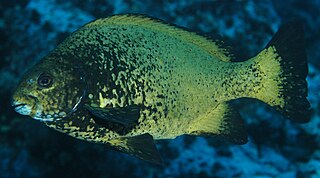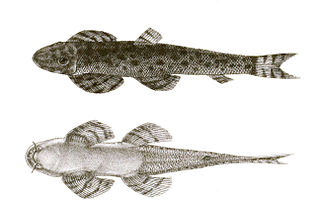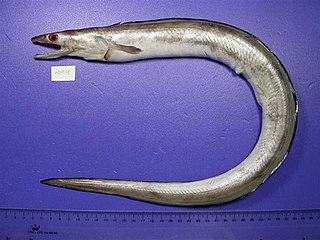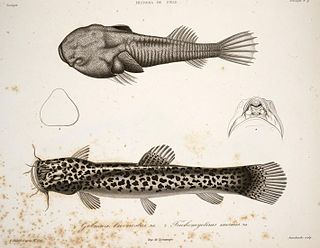
Trichogaster is a genus of gouramis native to South Asia from Pakistan to Myanmar. It is the only genus in the monotypic subfamily Trichogastrinae as set out in the 5th Edition of Fishes of the World, although that book states that there are two genera, the other being Colisa which is treated as a synonym of Trichogaster by Fishbase and the Catalog of Fishes. Fishbase also places the genus in the Luciocephalinae. Species of this genus are very popular in the aquarium trade.

The sea chubs, also known as rudderfish and pilot fish and in Hawaiian as enenue or nenue, are a family, Kyphosidae, of fishes in the order Perciformes native to the Atlantic, Indian and Pacific Oceans usually close to shore in marine waters.

Characodon is a genus of splitfins endemic to north–central Mexico. Two of the species are highly threatened and restricted to pools, ponds and springs in the upper San Pedro Mezquital River basin in Durango. The third species, C. garmani, was restricted to springs near Parras in Coahuila, but it became extinct when they dried out.

Dermatolepis is a genus of marine ray-finned fish, groupers from the subfamily Epinephelinae, part of the family Serranidae, which also includes the anthias and sea basses. They are found in the western Atlantic, Pacific and Indian Oceans.

Balitora is a genus of ray-finned fishes in the family Balitoridae endemic to Asia.

Cirrhinus is a genus of fish in the family Cyprinidae, the carps and minnows. Members of this genus are native to freshwater in South Asia, Indochina and southern China.
Henicorhynchus inornatus is a species of ray-finned fish in the genus Henicorhynchus, although some authorities classify it as member of the genus Cirrhinus. It is only found in the Irrawaddy and Sittang basins in Myanmar.

Muraenesox is a small genus of eels found throughout the Indo-Pacific. It currently has three described species as most species have been moved to other genera. Members are found in the Indo-West Pacific.

Henicorhynchus is a genus of cyprinid fish that occurs in Southeast Asia.
Sinilabeo is a genus of cyprinid freshwater fish found in China and Vietnam.

Selene is a genus of carangids, commonly known as lookdowns and moonfishes, native to the Atlantic Ocean and the eastern Pacific Ocean.
Gymnostomus is a genus of cyprinid fish found in Southeast Asia.

Incisilabeo is a monospecific genus of freshwater ray-finned fishes belonging to the family Cyprinidae, the family which includes the carps, barbs, minnows and related fishes. The only species in the gneus is Incisilabeo behri.
Decorus decorus is a species of freshwater ray-finned fish belonging to the family Cyprinidae, the carps, barbs, minnows and related fishes. This fish is endemic to China, where it has been recorded from the Xiyang Jiang, a tributary of the Xi Jiang, in Yunnan and the Bei Jiang in Guangdong and Guangxi Provinces. It is found in mountain streams with gravel beds and a fast current.
Decorus rendahli is a species of freshwater ray-finned fish belonging to the family Cyprinidae, the carps, barbs, minnows and related fishes. This fish is endemic to China, where it has been recorded from the basin of the Yangtze.
Decorus xanthogenys is a species of freshwater ray-finned fish belonging to the family Cyprinidae, the carps, barbs, minnows and related fishes. This fish is endemic to the basin of the Red River in Yunnan and northern Viet Nam.

Sicyases brevirostris is a species of clingfish from the family Gobiesocidae. It is endemic to the rocky intertidal zones of the Juan Fernández Islands, Chile. It was described in 1848 as Gobiesox brevirostris by Alphone Guichenot. Fishbase treats Sicyases hildebrandi as synonymous with S. brevirostris although some authorities still treat S. hildebrandi as a valid species.
Altigena is a genus of cyprinid freshwater fish found in the continental part of South East Asia. This genus was resurrected from Bangana by Maurice Kottelat in 2017.
Decorus is a genus of cyprinid freshwater fish found in China and India. This genus was split from Bangana in 2019.
Karstinnectes is a genus of freshwater ray-finned fishes belonging to the family Nemacheilidae, the stone loaches. The fishes in this genus are cavefish found in China.











